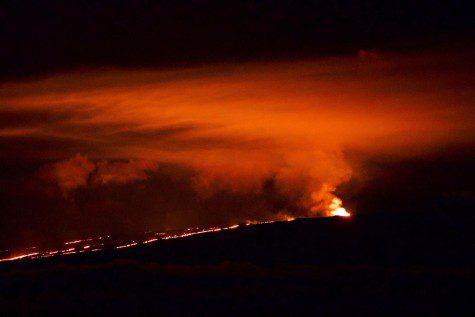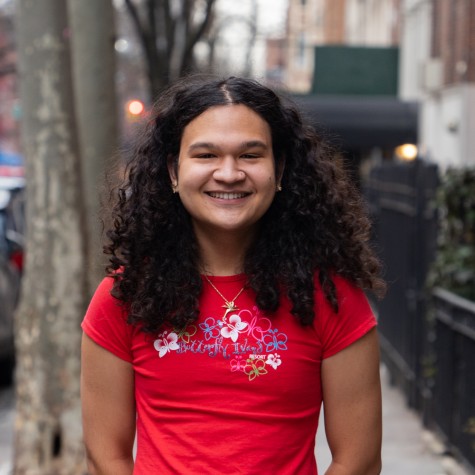What Mauna Loa’s eruption means as a Native Hawaiian
The recent eruption of the world’s largest active volcano on Hawaiʻi Island has spurred celebration among Hawaiʻi’s residents and its visitors.
December 6, 2022
E heluhelu i kēia moʻolelo ma o ka ʻŌlelo Hawaiʻi | Read this article in Hawaiian
Hulihia ka mauna, wela i ke ahi. The mountain is overturned, hot with fire.
When Mauna Loa last erupted in 1984, my mother was in elementary school. It did so less than 40 miles from her home in Hilo, Hawaiʻi, and stopped just four miles shy of her and the city. Her account of witnessing the approaching flow serves as a lasting reminder of this volcano’s innate power. And now, following 38 years of slumber, Mauna Loa once again displays its full strength.
Mauna Loa, which means “long mountain” in the Hawaiian language, erupted on the evening of Nov. 27 of this year — a half hour before Hawaiians celebrate Lā Kūʻokoʻa, or Hawaiian Independence Day. Lā Kāʻokoʻa commemorates the day in 1843 when England and France, through the Anglo-Franco Proclamation, and the United States verbally, acknowledged Hawaiʻi’s sovereignty. Many have viewed the eruption’s timing as a hōʻailona, or natural omen — it may be considered nature’s own celebration that runs parallel to Lā Kūʻokoʻa.
Hawaiians have revered volcanoes for their role in creating new land, which in turn births new life. The deity Pele, the goddess of volcanoes and fire, is responsible for this power of creation and destruction. Other names for Pele are Ka Wahine ‘Ai Honua, or The Earth-Eating woman, and Pelehonuamea, or Pele of the Sacred Earth. Native Hawaiians have practiced rites, including chanting, dancing, crafting lei and offering ceremonies, all throughout the islands in honor of this significant and central character’s return to Mauna Loa.
Although I have family living on Hawaiʻi Island, the widespread awe of Hawaiʻi’s spiritual and natural powers have lessened any worry for their safety. Videos that my brother posted to our family group chat show rivers of magma running down Mauna Loa’s slopes at night, casting a reddish glow across the sky. Rows of cars are parked beside the main highway to bear witness to this natural wonder. Despite being feared, Pele and her power are respected.
However, the island’s residents are not the only people enjoying the beauty of Mauna Loa’s eruptions. Tourists have flocked to the island to witness Pele’s grandeur, arriving at a time when tourism is normally low. Some businesses have come under fire for exploiting and commercializing Hawaiʻi’s traditional beliefs, which is nothing new to the locals.

The lava shows no direct threat to the people of the island, though the flow slowly approaches the island’s key highway, which connects the two most heavily populated living centers on Hawaiʻi. It wouldn’t be the first time lava has affected the island’s infrastructure. In 2018, when a new fissure rose in the Leilani Estates neighborhood, Pele wiped out an entire community in her path, including a beach house that was once owned by my great-grandparents.
People have long attempted to redirect or stop entirely flows of lava emanating from Mauna Loa. In 1881, as lava threatened the city of Hilo, Princess Ruth Keʻelikōlani approached the flow and offered chants, brandy and red scarves — the lava flow shortly thereafter turned cold. In 1935, the U.S. Army Air Services, at the command of the Hawaiian Volcano Observatory’s founder, dropped 20 600-pound bombs on Mauna Loa to halt its flow threatening Wailuku River, Hilo’s main source of water. The flow stopped before it reached the river, but whether the bombing assisted remains controversial.
When nature displays something as magnificent as a volcanic eruption, trying to conquer its path seems unreasonable. For Hawaiians, a knowledge of the natural world allows us to live in harmony with the land, even when it threatens us. Bearing witness to the majesty of Pele and her power, especially on a day as significant as Lā Kūʻokoʻa, only affirms what Hawaiians have known for generations — that the patriotism and steadfastness of their sovereignty erupts with the same fervor as the lava running down Mauna Loa’s slopes.
Even if I can’t personally witness the eruption, there is widespread enthusiasm during this time of hulihia, or upheaval. I experience the same sense of wonder that my mother did when she first witnessed a dormant volcano erupt, and the power of Hawai’i’s natural forces continues to evoke and create fond memories.
Contact Derek Kamakanaaloha Soong at [email protected].




























































































































































